Infrastructure as a Service (IaaS)

Table of contents
What is Infrastructure as a Service (IaaS)?
Infrastructure as a Service (IaaS) is a cloud computing model that provides virtualized computing resources over the Internet.
In an IaaS model, users can rent virtualized hardware resources, such as servers, storage, and networking, on a pay-as-you-go basis.
This eliminates the need for organizations to invest in and maintain physical infrastructure.
Popular examples of IaaS providers include Amazon Web Services (AWS), Microsoft Azure, and Google Cloud Platform (GCP).
Organizations leverage IaaS to build and deploy applications without investing in and managing physical hardware, reducing costs and increasing flexibility in managing IT infrastructure.
These benefits are being recognized at a rapid pace, and according to Gartner, infrastructure-as-a-service (IaaS) is forecasted to experience the highest end-user spending growth in 2024 at 26.6%.
Let’s imagine a scenario to help contextualize infrastructure as a Service (IaaS) within the realm of cloud computing.
Scenario: Setting up a website with IaaS
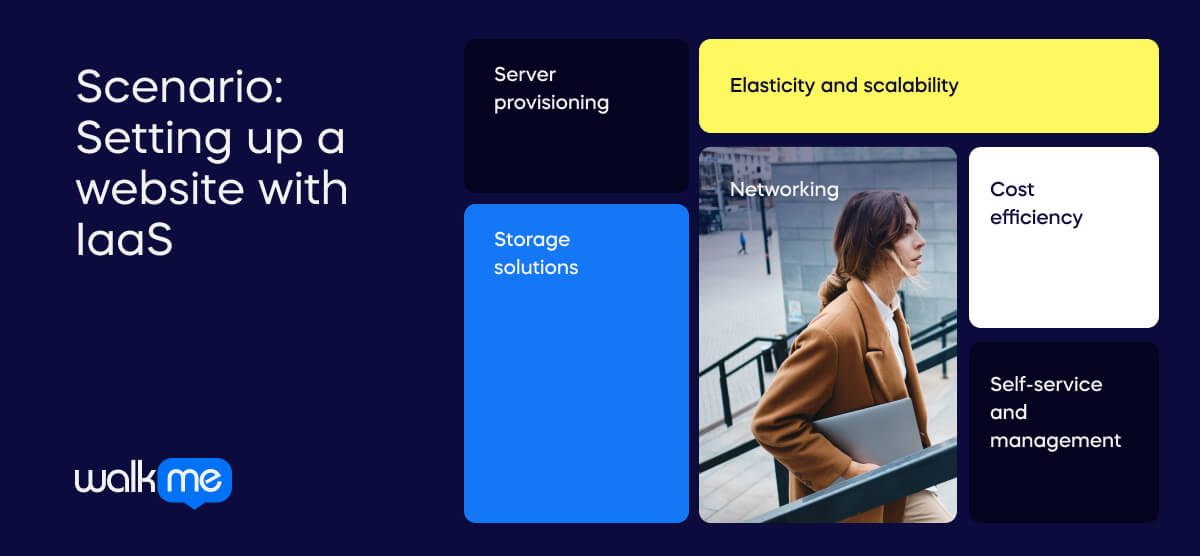
Imagine you have a great idea for a website and want to bring it to life. Traditionally, you would need to buy physical servers, set up networking equipment, and manage all the technical aspects of hosting your site.
However, with IaaS in the cloud, this process becomes much simpler. Here’s why:
Server provisioning
In a traditional setup, you would need to purchase physical servers. With IaaS, you can skip this step.
Instead, you visit an IaaS provider like Amazon Web Services (AWS), Microsoft Azure, or Google Cloud Platform (GCP).
You choose the type of virtual servers you need (e.g., how much processing power, memory, and storage), essentially renting them from the IaaS provider.
Storage solutions
You would typically have to buy and set up physical storage devices for your website’s data storage needs.
In the IaaS model, you can use virtual storage provided by the cloud service. This is flexible and can be easily scaled based on your requirements.
Networking
Setting up networking infrastructure can be complex and time-consuming.
With IaaS, the provider takes care of the underlying network infrastructure. You can configure your virtual networks, ensuring that your servers communicate effectively.
Elasticity and scalability
Let’s say your website becomes incredibly popular, and the traffic spikes. With traditional infrastructure, handling this increased demand would be challenging.
In the IaaS cloud, you can easily scale up your resources to accommodate the higher traffic and scale down when it decreases.
Cost efficiency
In a traditional model, you need to invest in hardware, even if your website isn’t initially experiencing high traffic.
With IaaS, you pay for what you use. If your site is small, you pay less. You can scale up as it grows, and your costs increase accordingly.
Self-service and management
With IaaS, you have a user-friendly interface or APIs that allow you to manage and control your virtual infrastructure.
This self-service aspect empowers you to configure, monitor, and maintain your resources without needing physical access to hardware.
Infrastructure as a Service (IaaS) empowers businesses by offering on-demand and scalable computing resources, reducing upfront capital investments, and enabling efficient resource allocation.
This enhances operational flexibility and fosters innovation, allowing the workforce to focus on strategic initiatives rather than managing hardware, thereby propelling businesses forward in the dynamic landscape of technology.
Why is Infrastructure as a Service (IaaS) important?
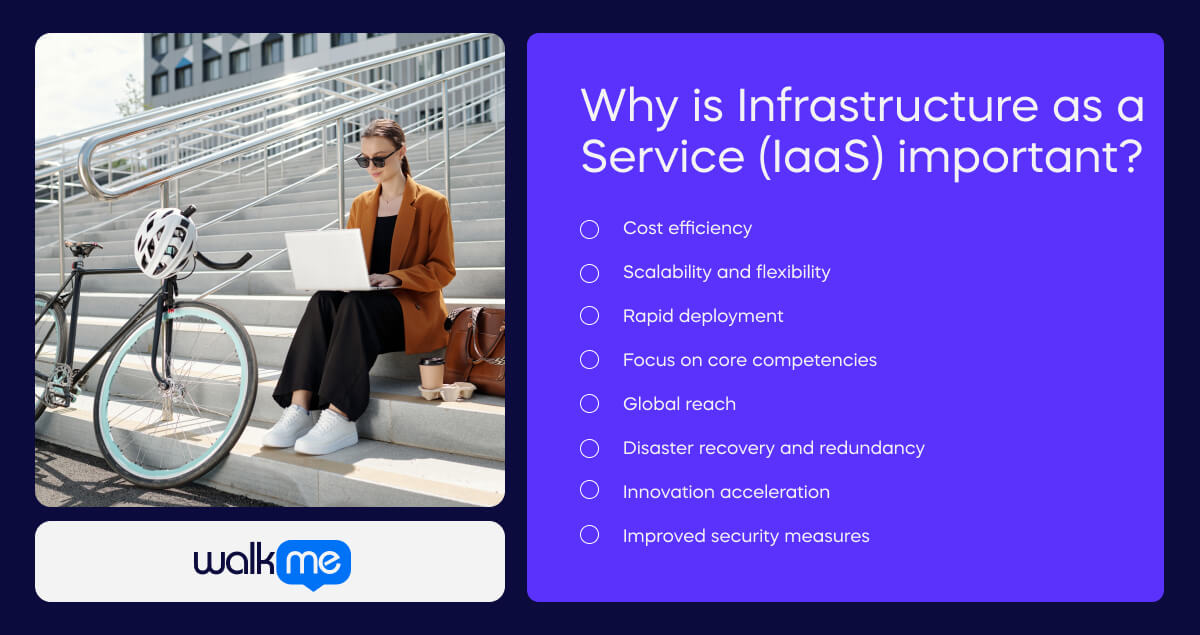
Infrastructure as a Service (IaaS) plays a crucial role in the business landscape for several reasons:
Cost efficiency
IaaS eliminates the need for organizations to invest heavily in physical infrastructure. Instead, they can use a pay-as-you-go model, reducing capital expenses and allowing for more efficient budgeting.
Scalability and flexibility
Businesses can easily scale their IT resources up or down based on demand. This flexibility is particularly valuable for handling variable workloads and adapting to changing business requirements.
Rapid deployment
IaaS enables rapid deployment of virtualized resources, significantly reducing the time it takes to set up and configure infrastructure. This agility is essential for businesses looking to quickly launch new applications or services.
Focus on core competencies
With IaaS, organizations can offload the management of underlying hardware to the service provider. This allows businesses to concentrate on their core competencies and strategic initiatives rather than getting bogged down in the complexities of infrastructure management.
Global reach
IaaS providers typically have data centers in multiple geographic locations. This global reach allows businesses to deploy resources closer to end-users, improving performance and responsiveness for a diverse and distributed user base.
Disaster recovery and redundancy
IaaS providers often offer built-in redundancy and disaster recovery options. This ensures data integrity and availability, reducing the risk of data loss and downtime in the event of hardware failures or unforeseen disasters.
Innovation acceleration
By leveraging IaaS, businesses can quickly adopt new technologies and stay at the forefront of innovation. This is because the service providers regularly update their infrastructure with the latest hardware and software capabilities, providing users with access to cutting-edge technology without needing constant upgrades.
Improved security measures
Reputable IaaS providers invest heavily in security measures, including data encryption, access controls, and compliance certifications. This helps businesses enhance the overall security of their IT infrastructure, often more effectively than they could achieve with on-premises solutions.
How WalkMe drives innovation with IaaS
Software as a Service (SaaS) company WalkMe has developed its Digital Adoption Platform using an Infrastructure as a Service provider.
By operating with this model, WalkMe can leverage robust, scalable, and secure infrastructure without needing to invest in and maintain its own hardware.
Utilizing a cloud platform enables WalkMe to focus on delivering value for customers instead of managing IT infrastructure.
IaaS has several benefits that drive organizational success and help overcome unique challenges. For instance, it provides scalability, allowing WalkMe to easily adjust its resources based on demand. This flexibility can lead to cost savings, as WalkMe only pays for the resources it uses.
Moreover, WalkMe can benefit from the latest advancements in cloud technology without requiring continual investment in hardware.
Recognizing the power of IaaS, WalkMe has created a SaaS company that successfully reduces digital friction and drives successful digital adoption of applications and workflows.
Using this model enhances customer experience by ensuring reliable service delivery.
It also drives efficiency by allowing WalkMe to focus on its core competency: developing a world-class Digital Adoption Platform.
Use Cases for Infrastructure as a Service (IaaS)
Infrastructure as a Service (IaaS) in business
IaaS finds practical applications across various contexts, offering flexibility, scalability, and cost-efficiency.
Here are some scenarios where IaaS is actively utilized:
Development and testing environments
Developers can use IaaS to quickly set up virtual machines, storage, and networking components for testing purposes.
This ensures efficient resource utilization and accelerates the software development life cycle.
Web hosting and application deployment
IaaS providers offer scalable infrastructure to host websites and applications.
Users can easily adjust resources based on demand, ensuring optimal performance during peak times and cost savings during periods of low traffic.
Big data processing
IaaS platforms provide the necessary infrastructure to deploy and scale big data processing frameworks such as Apache Hadoop or Apache Spark.
Users can provision virtual machines with the required processing power and storage to handle large-scale data analytics.
High-performance computing (HPC)
IaaS allows organizations to access high-performance computing resources on demand.
Researchers and organizations can leverage virtual machines with powerful CPUs and GPUs to run computationally intensive workloads without investing in and maintaining specialized hardware.
Content delivery networks (CDNs)
IaaS providers offer a global network infrastructure that can be leveraged to deploy CDNs.
This ensures that content, such as images, videos, and static files, is delivered quickly to users regardless of their geographical location.
How businesses find success with Infrastructure as a Service (IaaS)
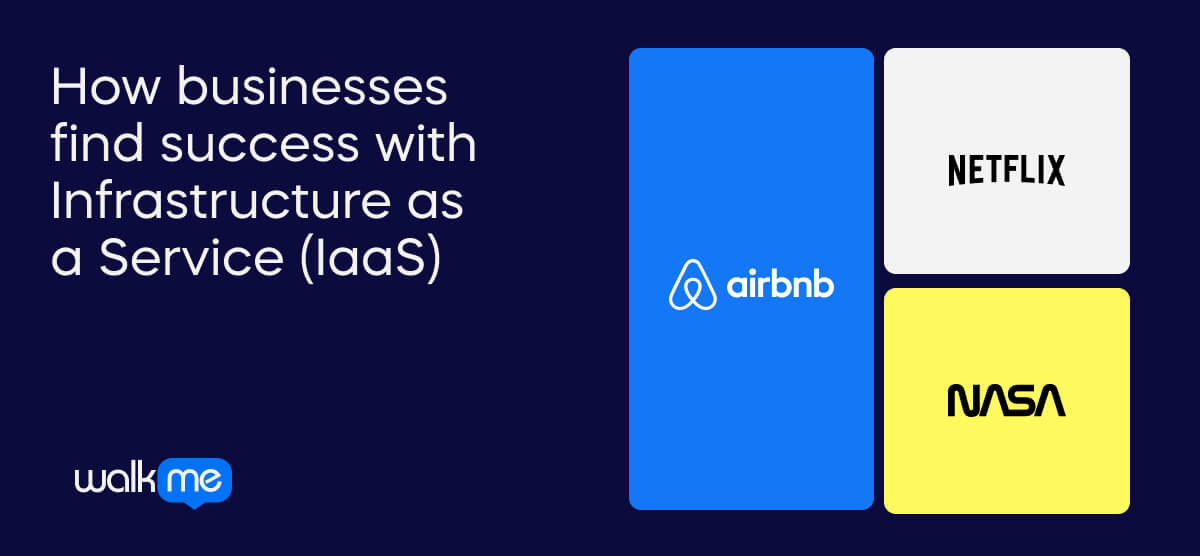
Businesses benefit from IaaS in various ways. Here’s an overview of how three top organizations utilize it in the digital space:
Netflix
IaaS feature
Scalability and resource efficiency
Digital adoption strategy
Netflix utilizes IaaS to manage its vast streaming infrastructure. During peak usage times, such as evenings and weekends, Netflix can dynamically scale its resources to handle the increased demand for video streaming.
By leveraging IaaS, Netflix ensures a smooth and uninterrupted streaming experience for millions of users worldwide.
The ability to scale resources up or down based on demand allows Netflix to optimize costs and maintain high-quality service, improving user experience and customer satisfaction.
Airbnb
IaaS feature
Global reach and reliability
Digital adoption strategy
Airbnb relies on IaaS to power its global platform for connecting hosts and travelers. The organization leverages the global presence of IaaS providers to deploy its services across multiple regions. This ensures low-latency access to the platform for users worldwide.
Additionally, IaaS provides robust and redundant infrastructure, enhancing reliability and resilience.
Airbnb’s use of IaaS contributes to a seamless and reliable user experience for both hosts and guests, fostering trust in the platform and supporting the company’s international expansion.
NASA
IaaS feature
High-performance computing (HPC)
Digital adoption strategy
NASA employs IaaS for its high-performance computing needs, particularly in running complex simulations and data-intensive scientific computations.
With IaaS, NASA can access powerful computing resources on-demand, enabling researchers and scientists to process vast amounts of data quickly. This capability is crucial for tasks like climate modeling, astrophysics simulations, and space exploration planning.
The adoption of IaaS in high-performance computing at NASA has led to accelerated research timelines, improved simulation accuracy, and enhanced scientific discoveries, showcasing the positive outcomes of leveraging IaaS for complex computational tasks.
Infrastructure as a Service (IaaS) vs Infrastructure as Code (IaC)
Getting Infrastructure as a Service (IaaS) and Infrastructure as Code (IaC) mixed up can be easy.
The key thing to remember is that while IaaS provides the infrastructure foundation in a cloud environment, IaC focuses on automating and managing the configuration of that infrastructure through code, offering efficiency, consistency, and scalability in infrastructure management.
Here’s an overview of their key differences:
| IaC | IaaS | |
| Definition | A practice that involves managing and provisioning infrastructure using code, typically in a declarative or imperative programming language. IaC allows infrastructure deployment, configuration, and management automation, providing a repeatable and consistent way to set up and manage infrastructure. | A cloud computing model where virtualized computing resources, such as virtual machines, storage, and networking, are provided over the internet. Users can provision and manage these resources on-demand, eliminating the need to invest in and maintain physical hardware. |
| Key characteristics | Declarative or imperative: IaC can be written in a declarative style (specifying the desired state) or an imperative style (defining the step-by-step process). Version control: Infrastructure code is often stored in version control systems (e.g., Git) for collaboration and versioning. Automation: IaC tools automate the deployment and configuration of infrastructure based on the code. | Resource provisioning: Users can provision and scale virtualized resources based on their needs. Elasticity: Resources can be scaled up or down dynamically to handle varying workloads. Managed by provider: The underlying infrastructure, including hardware and data center management, is the responsibility of the IaaS provider. |
| Use cases | Provisioning and configuring cloud resources. Creating and managing virtual machines, networks, and storage. Defining and deploying entire application environments. | Hosting applications and websites. Development and testing environments. Running virtual servers and databases. |
Relationship between IaaS and IaC
IaC is often used in conjunction with IaaS to automate the provisioning and management of cloud resources. Tools like Terraform, AWS CloudFormation, or Azure Resource Manager are examples of IaC tools.
It abstracts the configuration details into code, making it easier to manage complex infrastructures across different IaaS providers or environments.
The practice ensures that infrastructure configurations are consistent, reproducible, and versioned, reducing the risk of errors and promoting collaboration among development and operations teams.
Advantages of Infrastructure as a Service (IaaS)
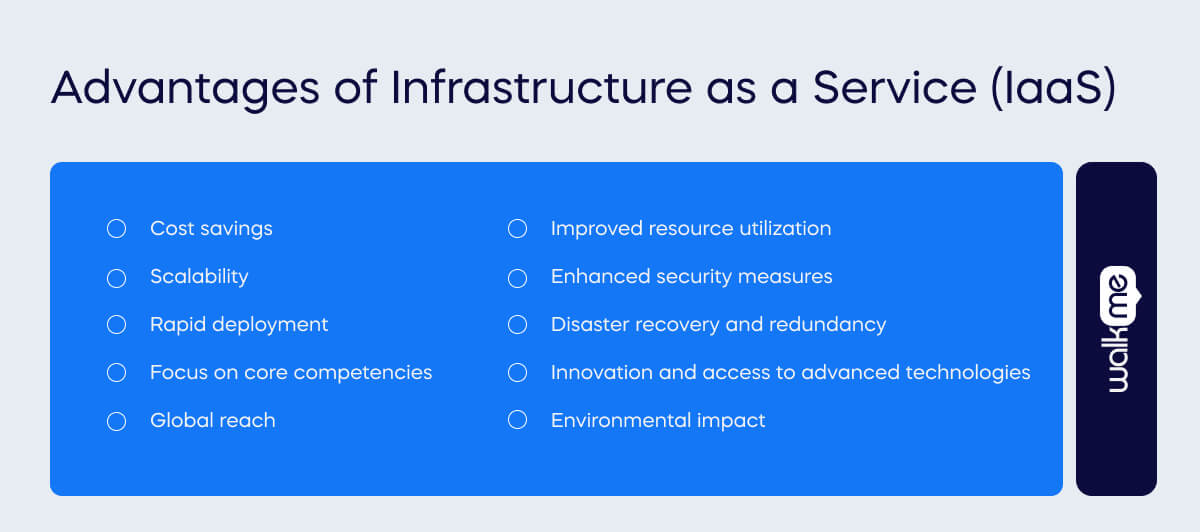
Infrastructure as a Service (IaaS) offers several advantages to businesses and organizations:
Cost savings
IaaS eliminates the need for upfront investments in physical hardware, allowing businesses to adopt a pay-as-you-go model.
This reduces capital expenses and provides cost flexibility as organizations only pay for the resources they consume.
Scalability
IaaS platforms allow businesses to scale their infrastructure up or down based on demand.
This flexibility is essential for handling variable workloads, accommodating growth, and adapting to changing business needs without the constraints of physical hardware.
Rapid deployment
Virtualized resources in IaaS can be provisioned quickly. This enables businesses to deploy applications and services faster, reducing time-to-market for new products or features.
Focus on core competencies
IaaS providers manage the underlying infrastructure, freeing organizations from the complexities of hardware maintenance.
This allows businesses to focus on their core competencies and strategic initiatives rather than managing IT infrastructure.
Global reach
Many IaaS providers have data centers in multiple geographic locations.
This global presence allows businesses to deploy resources closer to end-users, improving performance, reducing latency, and enhancing the user experience worldwide.
Improved resource utilization
IaaS allows organizations to optimize resource utilization by dynamically adjusting computing resources to match the workload.
This efficiency helps prevent underutilization of hardware, leading to better overall resource management.
Enhanced security measures
Reputable IaaS providers invest in robust security measures, including encryption, access controls, and compliance certifications.
Leveraging these measures can enhance the overall security of the IT infrastructure, often surpassing what many organizations can achieve on their own.
Disaster recovery and redundancy
IaaS providers typically offer built-in redundancy and disaster recovery options.
This ensures data integrity and availability, reducing the risk of data loss and downtime in case of hardware failures or unforeseen disasters.
Innovation and access to advanced technologies
IaaS providers regularly update their infrastructure with the latest hardware and software technologies.
Businesses can take advantage of these advancements without needing constant investment in upgrades, staying competitive and innovative in the rapidly evolving tech landscape.
Environmental impact
Consolidating resources in a shared, virtualized environment can contribute to energy efficiency.
IaaS can help businesses reduce their overall carbon footprint by optimizing resource usage and promoting a more sustainable IT infrastructure.
Challenges of Infrastructure as a Service (IaaS)
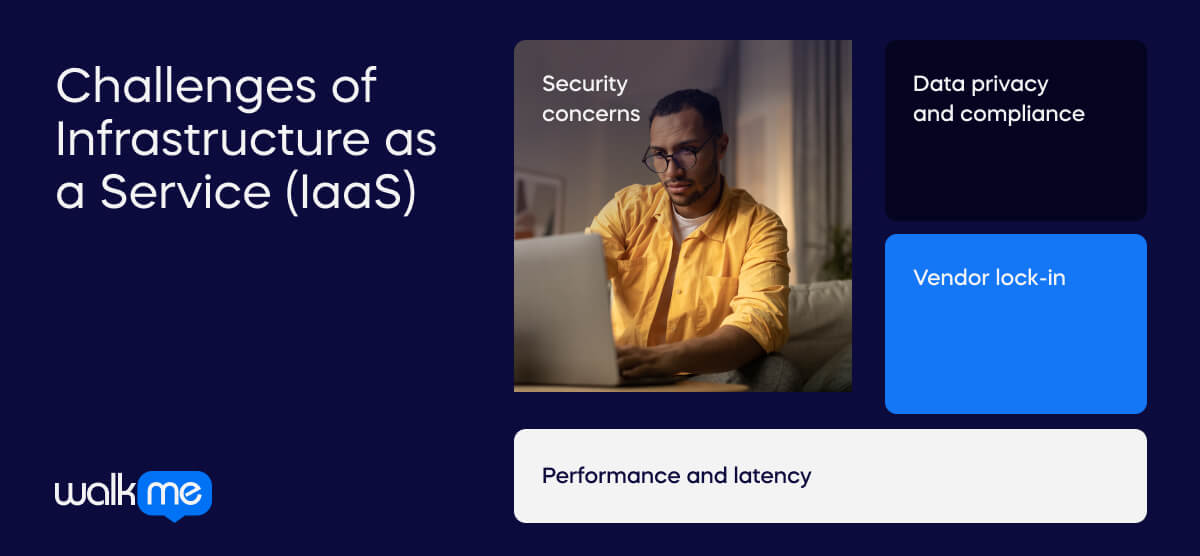
While Infrastructure as a Service (IaaS) offers numerous benefits, it also comes with its set of challenges.
Here are some common challenges associated with IaaS:
Security concerns
Security is a top concern when using IaaS. Organizations may worry about protecting sensitive data, potential breaches, and the shared nature of resources in a multi-tenant environment.
Data privacy and compliance
Organizations may face strict data privacy and compliance regulations depending on the industry and location. Ensuring that IaaS solutions adhere to these regulations can be challenging.
Vendor lock-in
Moving applications and data between different IaaS providers can be challenging, leading to potential vendor lock-in. This makes it difficult for organizations to switch providers if needed.
Performance and latency
The performance of IaaS solutions can be affected by factors such as network latency, virtualization overhead, and shared resources.
The future of Infrastructure as a Service (IaaS)
According to Gartner, the worldwide infrastructure as a service (IaaS) market grew 29.7% in 2022 to $120.3 billion, up from $92.8 billion in 2021.
The future of Infrastructure as a Service (IaaS) is expected to involve continued evolution and innovation in response to emerging technologies, changing business needs, and advancements in cloud computing.
Here are some trends that may shape the future of IaaS:
Edge computing integration
As more devices connect to the internet and generate vast amounts of data, there’s a growing need to process data closer to the source.
IaaS providers will likely integrate edge computing capabilities, allowing organizations to deploy and manage infrastructure at the edge for low-latency processing.
Serverless computing
Serverless computing, which allows developers to focus on writing code without managing the underlying infrastructure, is gaining popularity.
IaaS providers may offer more serverless solutions, enabling organizations to run applications in a more granular and cost-effective manner.
Hybrid and multi-cloud architectures
Organizations increasingly adopt hybrid and multi-cloud strategies to leverage the benefits of both on-premises and cloud-based infrastructure.
Future IaaS solutions may focus on providing seamless integration, management, and orchestration of resources across various environments.
AI and machine learning integration
IaaS providers will likely integrate artificial intelligence (AI) and machine learning (ML) capabilities into their platforms.
This can include offering specialized hardware for ML workloads, providing pre-trained models, and making it easier for organizations to implement and scale AI solutions.